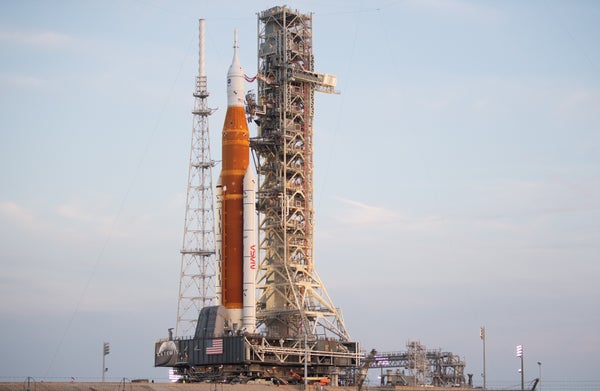NASA's Artemis 1 moon rocket headed back to the launch pad Tuesday night (Aug. 19) to take a step closer to a landmark lunar mission.
Artemis 1 is an uncrewed test flight of the huge Space Launch System (SLS) megarocket and its Orion spacecraft, and it began the rollout to a Kennedy Space Center launch pad at about 10 p.m. EDT (0200 GMT Wednesday, Aug. 17). By 7:30 a.m. EDT, it had reached its destination.
The Orion, stacked atop the rocket, began moving from the KSC's Vehicle Assembly Building for a journey that took more than 10 hours. The crawler carrying the Artemis 1 hardware had to make a journey to Launch Pad 39B at roughly 1 to 2 miles an hour (1.6 to 3.2 km/h).
On supporting science journalism
If you're enjoying this article, consider supporting our award-winning journalism by subscribing. By purchasing a subscription you are helping to ensure the future of impactful stories about the discoveries and ideas shaping our world today.
NASA elected to bring the rocket out a full two days earlier than planned. The agency said on its Artemis blog(opens in new tab) that the team finished flight termination system testing, the last major activity required until the rocket was closed out and the final access platforms at the VAB were retracted.
NASA has not released a detailed schedule of the rollout, which is expected to last between 8 and 11 hours depending on weather conditions, road conditions and other technical matters.
Blastoff of the uncrewed mission is scheduled for no earlier than Aug. 29, and will bring the Orion spacecraft around the moon on a test of the vehicle's system for future human missions. In between will be several webcasts of the science and other tech on board the mission.
NASA hopes to send an Artemis 2 mission to orbit the moon, with people on board, as soon as 2024 with a landing mission, Artemis 3, set for 2025.
Copyright 2022 Space.com, a Future company. All rights reserved. This material may not be published, broadcast, rewritten or redistributed.
